Arthur John Trevor Briscoe stands as a significant figure in early 20th-century British art, celebrated primarily for his dynamic and technically brilliant depictions of the sea and sailing vessels. Born in 1873 and passing away in 1943, Briscoe dedicated his artistic life to capturing the power, beauty, and intricate reality of maritime life. He was not merely an observer but an experienced sailor himself, a fact that imbued his work with an authenticity and understanding rare among marine artists. Working proficiently across oil painting, watercolour, and particularly etching, Briscoe carved a unique niche for himself, leaving behind a legacy of images that continue to resonate with lovers of the sea and fine art alike.
Early Life and Artistic Formation
Arthur John Trevor Briscoe was born in Bournemouth, England, in 1873. While born in a coastal town, some accounts suggest early connections to the bustling maritime environment near Liverpool, perhaps fostering his lifelong fascination with the sea. His formal education took place at the prestigious Shrewsbury School, after which his artistic inclinations led him to pursue formal training.
His journey into the art world began in London at the renowned Slade School of Art. There, he studied under Professor Fred Brown, a prominent figure associated with the New English Art Club and known for encouraging a more modern, observational approach compared to traditional academic methods. The Slade, during this period and the surrounding years, was a crucible of talent, with figures like Augustus John and William Orpen also passing through its doors, contributing to a vibrant atmosphere of artistic exploration under influential teachers like Henry Tonks.
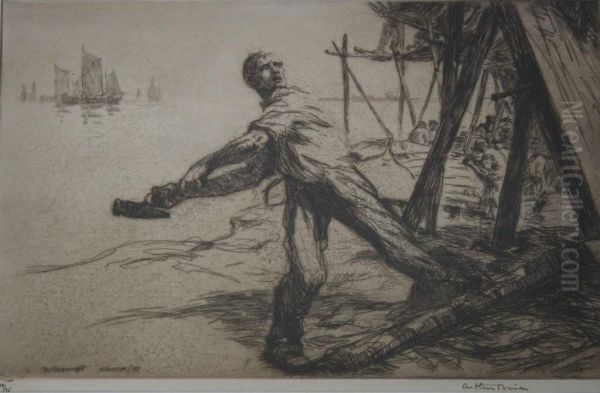
Seeking further refinement and exposure to different artistic currents, Briscoe travelled to Paris, the undisputed centre of the art world at the time. He enrolled at the Académie Julian, a famous private art school that attracted students from across the globe. While specific teachers mentioned in some sources are unclear, the Académie Julian was known for instructors like William-Adolphe Bouguereau and Jean-Paul Laurens, offering rigorous training, though Briscoe's own developing style would diverge significantly from the polished academicism often associated with the institution. This period abroad broadened his horizons and technical skills, preparing him for a career dedicated to his chosen subject.
Embracing the Sea: A Life Afloat
Upon completing his formal art education, Briscoe's passion for the sea took a practical turn. He was not content to merely paint seascapes from the shore or from imagination. Instead, he purchased his own sailing vessel, the 'Golden Vanity', a three-ton cutter. This decision was pivotal, transforming him from an artist interested in the sea into an artist deeply immersed in the seafaring life.
He embarked on extensive voyages, navigating the coastal waters of Great Britain and venturing further into the challenging seas around Northern Europe, including Holland, Belgium, and France. These were not leisurely cruises; they were working trips dedicated to observation and creation. He experienced firsthand the demanding life aboard sailing ships, the changing moods of the weather, the complex mechanics of sail and rigging, and the sheer physical power of the ocean. This direct experience became the bedrock of his art.
Briscoe grew dissatisfied with what he perceived as the static and often formulaic conventions prevalent in much traditional marine painting. He sought a more dynamic and truthful representation. In this, he consciously looked to the example of the great British master, J.M.W. Turner, who famously subjected himself to the elements, even reportedly being lashed to a mast during a storm, to better understand and depict the sea's fury. While perhaps not resorting to such extremes, Briscoe's commitment to authenticity was profound.
His dedication led him to design and build a specially adapted small boat, robust enough to allow him to sketch and paint even in rough weather conditions. This floating studio enabled him to capture the immediacy and energy of the sea in a way few others could. His deep knowledge of sailing was not just artistic inspiration; he also shared it practically, authoring and illustrating a handbook on yacht handling titled 'A Handbook on Sailing', published under the witty pseudonym "Clove Hitch," a type of nautical knot.
The Art of Etching: Technique and Vision
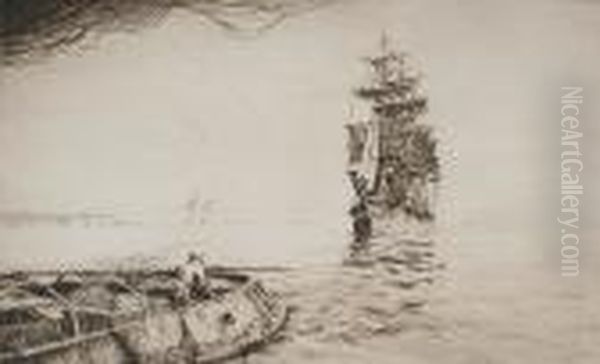
While Briscoe worked capably in oils and watercolours, it was in the medium of etching that he truly excelled and gained widespread recognition. He became one of the foremost marine etchers of his generation, bringing a fresh perspective and technical mastery to the form. The Etching Revival, which had gained momentum in the latter half of the 19th century with figures like James McNeill Whistler and Sir Francis Seymour Haden, was still a powerful force, and Briscoe contributed significantly to its 20th-century continuation alongside contemporaries like Sir Frank Short, Muirhead Bone, and fellow marine specialist William Lionel Wyllie.
Briscoe's etchings are characterized by their vigorous line work, dramatic compositions, and exceptional attention to detail, particularly concerning the complex rigging and structure of sailing ships. He often favoured drypoint, a technique where the image is scratched directly onto the copper plate with a sharp needle. This method produces a slightly blurred, rich line known as 'burr,' adding texture and depth, perfectly suited to depicting the interplay of light, shadow, and atmosphere at sea.
His works capture ships in action – battling heavy seas, sails straining against the wind, or crews engaged in the arduous tasks of seamanship. There is a palpable sense of movement and energy in his prints. Titles often reflect the specific nautical manoeuvres or conditions depicted, revealing his intimate understanding. His perspective is frequently that of someone on deck, looking up at towering masts and sails or out at the challenging waves, immersing the viewer in the scene. This perspective lends his work what has been described as a "sailor's joy" – an authentic feel for the vessel's motion and the mariner's experience.
Representative Works
Briscoe produced a significant body of work, particularly in etching, between the mid-1920s and the early 1930s. Several pieces stand out as representative of his skill and thematic focus:
Securing the Boats (1928): This powerful etching, held in collections like the Yale Center for British Art, exemplifies his ability to convey the drama of heavy weather at sea, focusing on the crew's efforts to manage the ship's smaller boats amidst challenging conditions. The dynamic lines and atmospheric effects showcase his mastery of the medium.
The Shipwright (1927): Housed in the Davison Art Center at Wesleyan University, this print shifts focus slightly from the open sea to the construction of vessels. It demonstrates Briscoe's appreciation for the craftsmanship involved in shipbuilding, rendering the textures of wood and the forms of the hull with precision.
Outward Bound (1927): An etching often employing drypoint, this work captures the sense of departure and adventure as a vessel heads out to sea. The rendering of the sails and the ship's movement through the water is characteristic of Briscoe's dynamic style.
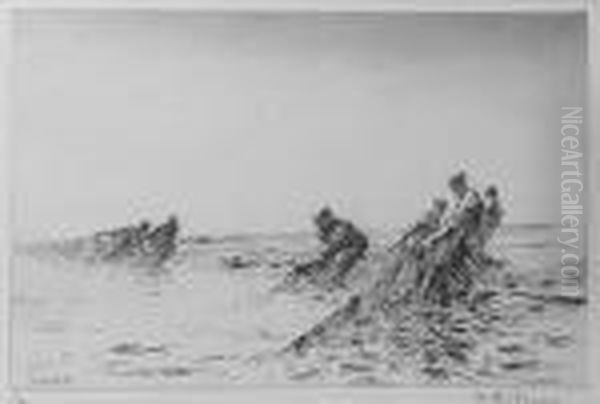
Casting Her Off (1927): Similar in theme and period to Outward Bound, this etching likely depicts the moments before setting sail, focusing on the lines and activity involved in releasing the ship from its moorings.
James & John (1928): The title suggests a focus on a specific vessel or perhaps figures aboard, rendered with Briscoe's typical attention to nautical accuracy.
The Fore T'Gallant Sail (1927): This title points to a specific sail high on the mast (the fore topgallant sail), indicating a detailed study of rigging and sail handling, likely emphasizing the height and precariousness involved in working aloft.
The Seine Net (1925): This earlier etching likely depicts fishing vessels using seine nets, showcasing Briscoe's interest in various forms of working boats and maritime life beyond large square-riggers.
The Cutty Sark under full sail: Though the medium isn't specified in all references, depictions of famous clippers like the Cutty Sark were popular subjects. Briscoe's version would undoubtedly capture the grace and speed of this iconic vessel.
The Winkle Picker and On the Hard: These etchings, noted as appearing with labels from the Royal Exchange Gallery, likely depict smaller coastal craft or scenes related to boat maintenance ('on the hard' referring to a boat out of the water for work).
These works, among many others, demonstrate Briscoe's consistent focus on the realities of sailing, his technical proficiency, and his ability to convey both the grandeur and the grit of life at sea.
Beyond Etching: Painting and Watercolours
While etching formed the core of his reputation, Arthur Briscoe was also an accomplished painter in both oil and watercolour. His approach in these media mirrored the concerns seen in his prints: a focus on marine subjects, accuracy in depiction, and an interest in capturing light and atmosphere.
His oil paintings, such as On the Thames (dated 1902 in one source), show his ability to handle colour and tone to depict bustling river scenes or open seascapes. These works often possess a solidity and textural quality inherent to the medium, complementing the linear focus of his etchings. He applied his keen observational skills, honed through years at sea, to capture the reflections on water, the forms of clouds, and the varied appearances of vessels under different light conditions.
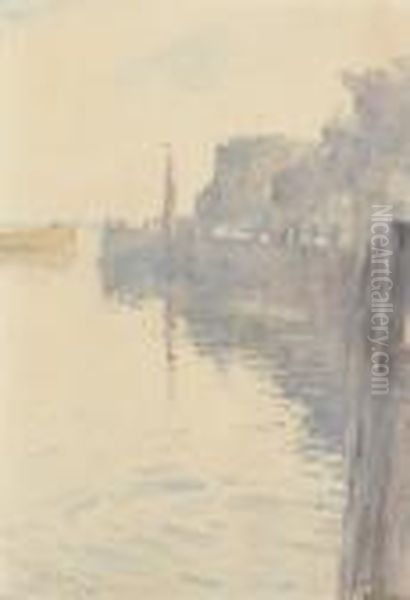
Briscoe was also highly proficient in watercolour, a medium well-suited to capturing the transient effects of light and weather at sea. His skill in this demanding medium earned him significant recognition. He exhibited regularly with the Royal Society of Painters in Water Colours (RWS), one of the oldest and most prestigious watercolour societies in the world. His contributions were valued to the extent that he was elected an Associate member (ARWS) and later achieved full membership (RWS) in 1933. This affiliation placed him among the leading watercolourists of his day. His watercolours likely shared the dynamism of his etchings but with the added dimensions of fluid colour and transparency.
Recognition, Exhibitions, and Context
Arthur Briscoe achieved considerable success and recognition during his lifetime. His work found favour with critics, collectors, and fellow artists. He exhibited widely at major London and regional venues, ensuring his art reached a broad audience.
His participation in exhibitions at the Royal Academy of Arts (RA) was a mark of professional standing. He also showed frequently with the Royal Institute of Painters in Water Colours (RI), the New English Art Club (NEAC) – an organization initially founded as an alternative to the RA and associated with his Slade tutor Fred Brown – and the Royal Society of British Artists (RBA). His work was also seen further afield, including at the Walker Art Gallery in Liverpool and the Glasgow Institute of Fine Art. Commercial galleries such as the Fine Art Society, Brook Street Gallery, Connell & Sons Gallery, and the Redfern Gallery also handled his work, indicating a healthy market for his art.
The success of his etchings was significantly boosted by his publisher, H.C. Dickins (also referred to as H.D. Dickins or Kingsley & Dinsdale in various sources, suggesting possible business changes or variations in naming). Dickins actively promoted Briscoe's prints, often selling them through subscription, a common practice for limited edition etchings at the time. Many editions sold out quickly, and his prints began to command strong prices at auction even during his lifetime, a testament to their popularity and perceived quality. Labels from galleries like the Royal Exchange Gallery found on some prints further attest to their circulation in the art market.
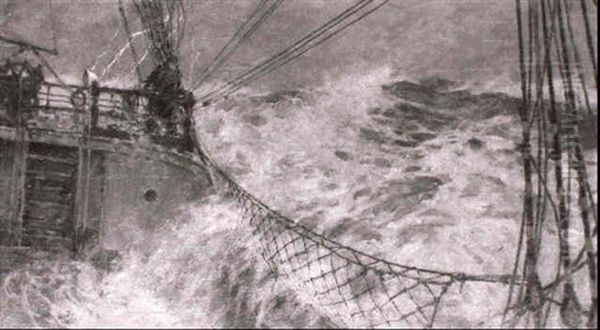
Placing Briscoe in context, he operated during a period of continued interest in traditional maritime subjects, but also one where modern art movements were gaining ground. While not an avant-garde modernist, Briscoe's direct, experiential approach set him apart from purely academic marine painters. He shared the seas as a subject with contemporaries like William Lionel Wyllie (who was also a prolific etcher), Charles Napier Hemy (known for his vigorous coastal scenes), and later, the highly popular Montague Dawson. However, Briscoe's emphasis on the view from the deck and the mechanics of sail often gives his work a distinct, immersive quality. His technical skill in etching aligns him with masters of the Etching Revival like Whistler, Haden, Short, and Bone, while his subject matter connects him to the long tradition of British marine art stretching back through Clarkson Stanfield and E.W. Cooke to the foundational influence of Dutch masters like Willem van de Velde the Younger. His bold compositions sometimes echo the decorative strength found in the work of Frank Brangwyn, another versatile contemporary active in printmaking.
Legacy
Arthur John Trevor Briscoe died in 1943, leaving behind a significant body of work dedicated almost entirely to the sea. His legacy rests on his exceptional skill as an etcher and his authentic portrayal of sailing ships and the seafaring life. He successfully bridged the gap between artist and mariner, using his deep, practical understanding of the sea to inform his artistic vision.
His work avoided romanticized or overly picturesque views, instead focusing on the dynamic reality of vessels interacting with the elements and the labour involved in sailing them. The accuracy of his depictions of rigging, sail handling, and ship construction makes his work a valuable historical record as well as fine art. He captured an era when commercial sail was declining but still a powerful presence, preserving its essence with technical brilliance and genuine feeling.
Today, his etchings are highly sought after by collectors of marine art and fine prints. His works are held in numerous public collections, including major maritime museums and art galleries in the UK and internationally, such as the Yale Center for British Art and the Davison Art Center at Wesleyan University. Arthur Briscoe remains a respected figure, admired for his technical mastery, his unwavering focus on his chosen subject, and his ability to convey the enduring power and allure of the sea.